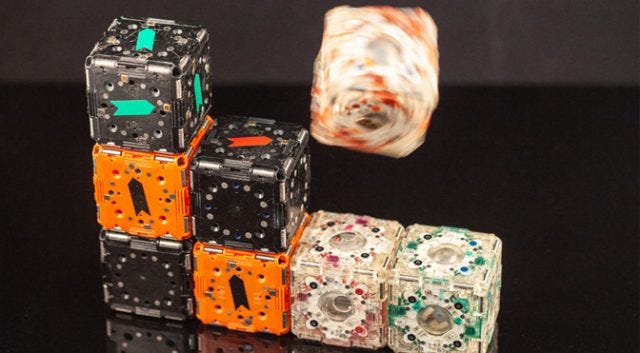Innovative MIT M-Block Robots: Rolling, Jumping, and Forming Shapes
Written on
Chapter 1: Introduction to M-Block Robots
MIT has pushed the boundaries of robotics with the creation of M-Block robots, which, although simple in design, exhibit remarkable collaborative capabilities. Unlike intricate robots that walk or run, these small cubes can autonomously navigate and interact with one another. While a single M-Block may seem limited in function, their true potential emerges when they unite to construct various shapes and structures.
The M-Blocks are a product of research at MIT’s Computer Science and Artificial Intelligence Laboratory (CSAIL), guided by professor Daniela Rus. The initiative began in 2013, focusing on developing a scalable robotic system that simplifies movement without relying on complex mechanisms. By utilizing "inertial forces," the team engineered these six-sided robots, culminating in the innovative M-Block design.
Section 1.1: Mechanism of Movement
Each cube-shaped robot is equipped with a flywheel spinning at an impressive 20,000 revolutions per minute. To initiate movement, the robot engages the brake on the flywheel, allowing it to roll and hop by utilizing the stored angular momentum. Additionally, each side is fitted with permanent magnets, facilitating connections with other M-Blocks, while small barcodes enable the robots to recognize one another.
Subsection 1.1.1: Directions and Movement
Despite their unique capabilities, M-Blocks are not the fastest in terms of reaching destinations compared to wheeled or legged robots. They can only advance in one of the four cardinal directions from any of their six faces, totaling 24 possible movement angles. To navigate towards one another, the cubes must launch themselves and depend on the magnets to align upon impact, allowing them to traverse significant distances with each jump and even scale "walls" made of other M-Blocks.

Section 1.2: Advantages of M-Block Design
This straightforward method of movement provides several benefits for the M-Block project. The robots are cost-effective and easy to manufacture due to their minimalist design with fewer moving components. This also means they are less susceptible to damage and require less maintenance compared to more complex robotic systems. The team is optimistic about the scalability of this design, projecting that it could potentially expand to a million modules.
Chapter 2: Future Applications and Potential
Professor Rus envisions a network of M-Blocks that can adapt to various needs in real-time. For instance, they could join together to create a makeshift staircase, enabling access to buildings affected by disasters like fires. Although the current capabilities of M-Blocks are limited to forming basic shapes, advancements in algorithms and inter-block communication could pave the way for more sophisticated functionalities.
The first video showcases how MIT's M-Blocks can move and connect, demonstrating their ability to form structures autonomously.
In the second video, you can explore how M-Blocks self-assemble into modular robots, highlighting their innovative design and collaborative potential.